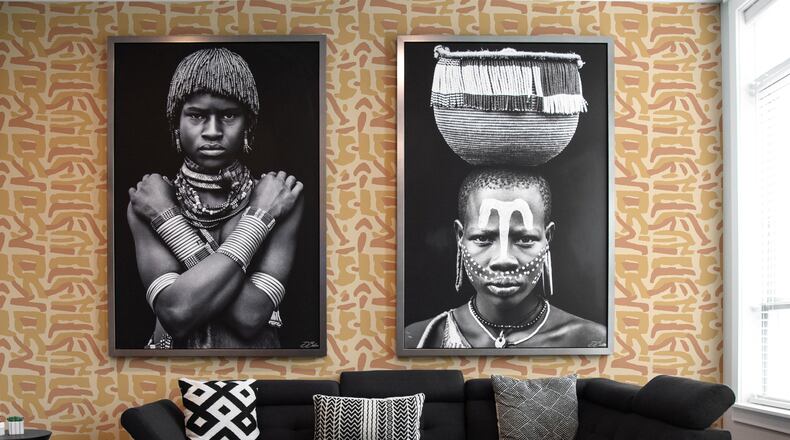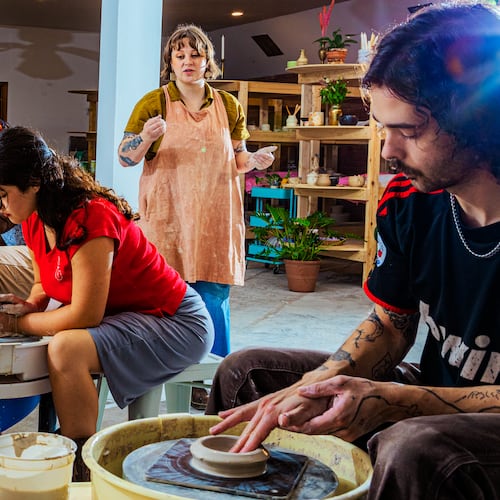For generations the words “heritage” and “traditional” in home decor tended to signify European design: Chippendale desks and French provincial sideboards and recognizable symbols of predominately British or French historical style.
But as with so many other things shifting in our culture, design is undergoing an overhaul in just what constitutes heritage. These days interior designers are incorporating Black, Asian, Native American, Indian, Hispanic and many other elements of homeowners’ cultural heritage into their home decor.
Influential designers such as New York-based Sheila Bridges have played with tradition in witty new ways. Her Harlem Toile wallpaper turns a hyper-traditional toile wallpaper pattern on its head. Traditional toile features vignettes of European pastoral life. Bridges mashes up toile’s historical tropes and the boom boxes, basketball and jump rope that she uses as cheeky shorthand for “Harlem” in her revisionist toile.
For Atlanta interior designer Amber Guyton of Blessed Little Bungalow, heritage is multifaceted, a combination of her roots in Lowcountry South Carolina and her African ancestry.
Visiting Charleston as a child, Guyton was entranced by the sweetgrass baskets, rooted in West African traditions, made by South Carolina craftswomen and considered some of America’s oldest handicrafts with African origins.
Credit: Mecca Gamble McConnell
Credit: Mecca Gamble McConnell
Guyton just launched a line of six wallpaper patterns for Chicago-based design company Mitchell Black that incorporate heritage. One of those wallpaper designs, Lowcountry Sweetgrass, is inspired by those traditional baskets and connects the designer to aspects of her heritage as both a Southerner and as the descendent of enslaved people.
“In developing this wallpaper collection, it was really important to me to create what I didn’t see in the world and also celebrate it,” Guyton said.
“I did my ancestry almost a decade ago,” added Guyton, who discovered that her roots in South Carolina and Mississippi “trace back to slavery and the African countries that I have roots in: Nigeria, Cameroon, Mali, Ghana.” Another one of her Mitchell Black wallpaper patterns, Tribal Traditions, was created to express the beauty of that African ancestry.
Guyton also often helps her clients incorporate objects, photographs or design elements that connect to their personal or cultural heritage. She came up with the idea for an Indian client to display her grandmother’s saris in shadowboxes. Another client worked with Guyton to create a dedicated “legacy room” featuring a grand aunt’s piano and a collection of photo albums. Rather than storing photos away in an attic, Guyton said, “she’s going to use this room to celebrate her heritage and her legacy.”
Credit: Brittany Bah Photography
Credit: Brittany Bah Photography
Guyton recommends blowing up family photos for display, “shopping” relatives’ homes for a beloved heirloom you can show in your own space or highlighting a family member’s beloved collection of coins or quilts as part of your interior design. You can also take inspiration from vintage colorways and paint a room in the hues of your father’s childhood baseball team uniform or grow hydrangeas in your garden in honor of a grandmother who loved them, as Guyton does.
Like Guyton, Davis thinks that even if you don’t have the original objects you grew up with, resale sites or antique stores offer the opportunity to re-create a treasured heirloom piece.
“Shopping vintage is always a nice way to try and find something that speaks to your past but that might be from your cultural heritage. And then I love to look on Etsy as well, because there are so many makers from around the world. So it’s sort of a global market, where you can find things that might speak to your heritage.”
Credit: Emily J Followill
Credit: Emily J Followill
Atlanta designer Jessica Davis of Atelier Davis grew up surrounded by artwork and decorative objects that her parents collected on their travels that she has now incorporated into her own Buckhead home. Davis has made her Chinese American heritage (her mother is Chinese and her father is from Texas) a component of her interior design practice.
“I come from a very artistic family, and my parents have always had really interesting Asian antiques,” Davis said. “And I grew up in Hong Kong. So in my entryway I have a rug which is something that my dad collected when he traveled on the Silk Road in China in the 1980s.”
Davis grew up with a strikingly modern NychairX by Japanese designer Takeshi Nii in her parents’ home. Although her parents no longer had the chair, Davis tracked one down at a store in Santa Monica, Calif. “I thought it was a cool nod back to those memories.”
Davis also has a snuff bottle collection (these relics of China’s Qing dynasty contained powdered tobacco) that references her Asian heritage. She has also incorporated Asian influences into her home with a rich red sofa and a modern take on a Tibetan tiger rug.
Credit: Emily J Followill
Credit: Emily J Followill
Davis observes more and more of her clients requesting artwork or furnishings that reflect their cultural heritage. Several of her clients feature work by African American artists such as Atlanta’s Shanequa Gay in their homes.
Davis recommends rethinking the original purpose of an heirloom piece to make it work in your interior design. For instance, she turned her grandmother’s collection of embroidered handkerchiefs into throw pillows in her home.
Though some people make their homes into showrooms, “most people want it to be very personal and custom and feel collected,” Guyton said. “And a big piece of that is celebrating who you are and where you come from.”
Felicia Feaster is a longtime lifestyle and design editor who spent 11 years covering gardening, interior design, trends and wellness for HGTV.com. Felicia is a contributor to MarthaStewart.com and has been interviewed as a design expert by The New York Times, Forbes and the Associated Press.
About the Author
Keep Reading
The Latest
Featured







